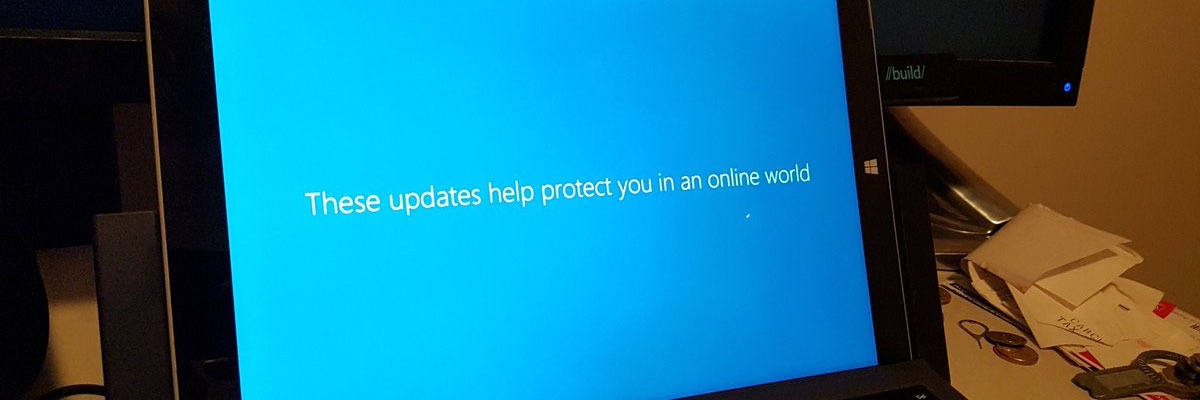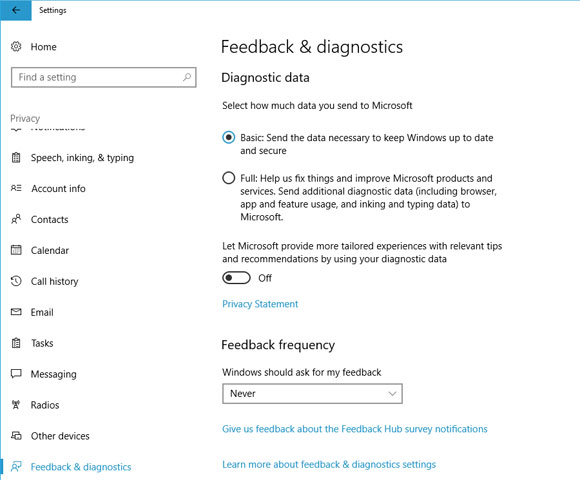When Windows 10 stealthily pushes an update on to my machine, I get anxious.
The unexpected restart closes all my active incognito (thus irrecoverable) browser tabs, my open documents and unsaved work, leaving it up to my own memory to restore everything prior to the reboot.
But the worse thing is that I have no immediate idea what got installed on my machine when the computer starts back up. I have to go through a routine of actively searching for changes, uninstalling any rogue applications, and making sure all data and privacy settings are in tact.
At start-up, the update process gives me a slightly less than comforting message:
Why is this less than comforting? Well, in today’s online world, there is an awful lot of snoop and spyware being installed by these very companies purporting to “protect” us. It worries me particularly because of the active censorship efforts of Google, YouTube, Facebook, Twitter, Microsoft and other tech companies that have jumped on the big data bandwagon. Your e-mails, conversations, files, apps and all other sorts of data are being mined and collected not only to be sold to advertisers, but to be sent to authorities, to rat you out in case there’s a perceived instance of “wrong-think”.
Your freedom and privacy is being sold off to the highest bidding corporations and corrupt governing ideologues.
With all the potential backdoors too comes the possibility of third-party hackers exploiting any poorly written software and getting hold of that big data, your personal and financial information, your confidential work documents and more.
When Windows suddenly and automatically launches the setup host in the background, slowing my computer to a crawl, I go into lock-down mode unaware that it’s just Windows taking over the machine, assuming that a virus or such has taken over the computer. The fact that Windows 10 updates behave like malware doesn’t bode well for Microsoft’s image. I realize we were warned back in the good old days of Windows 7 when GWX.exe, the “Get Windows 10” ad-ware, was the interminable program constantly begging Windows 7 users to upgrade. The Windows 10 upgrade was free for a reason: instead of paying in dollars, we would pay the price with our privacy and data.
The best one can do to minimize the telemetry and data mining and maximize your control over the environment is to go into Settings, start uninstalling as many of the unused apps that come with these updates, and ensure your privacy and update settings are set to the lowest level of intrusion possible. There is no guarantee of safeguarding most of your data since nothing tells us specifically what is considered “basic”:
I feel these updates don’t help protect anyone in an online world. The fact that Cortana can’t be fully disabled, diagnostic data can’t be fully disabled, and automatic installation of updates can’t be fully disabled — these updates are instead worrisome in an online world.
* * *
If you liked this article, be sure to leave a comment, share, bookmark and subscribe to the RSS feed.







One word: Linux. Choose one distro (I’d like to recommend Debian) install it and be happy in on line, off line and whatever world.
Yeah, I wish they’d stop trying to “protect” me. That’s my job.
Just leave my computer alone, Microsoft. I take care of my computer’s security, and I don’t appreciate Microsoft closing my browser and stealing my computer from me, even for a few minutes.
If updates scare you, you should be more afraid of not updating and patching your apps, system and bios. 38 years of corporate and cybersecurity experience have taught me one thing, turning a blind eye to security hurts and it’s costing the U.S. economy billions of dollars a year. Patching is important to remediate CVE or Common Vulnerability Exposures and these can be exploited by bad actors anywhere in the world just by browsing the internet. Morpheus told Trinity in the Matrix not to get on the highway because it’s dangerous and I’m telling you not to get on the information highway unless your fully patched because it’s dangerous. More than one of my personal friends has had their PCs hacked and many new clients enlist my organization after a catastrophic data breach. So next time you read the banner that “these updates protect you in an online world” BELIEVE IT.
I agree and I am not condoning one extreme (update nothing) over the other (automatically install anything and everything).
For those zero-day exploits, I am all for applying updates ASAP. But why can’t we simply choose what and when to install all the other updates, just like we do already for our Linux distributions? Or at least give the option to advance users that are on their computers 365 days a year?
It’s the sneaking in of all the miscellany in these auto-updates, which are prone to more security and privacy issues as I’ve stated in my article, that bothers me.
It’s like those giant omnibus bills government passes through legislation. One important issue is stated and one important policy is proposed, but those bills are frequently backed by 200+ more pages of unrelated and unnecessary legislation. It is obvious that the bill is doing more to harm to us, and more to benefit bureaucrats.
I’m just asking for a return to some self-governance with respect to Windows updates. Give an option for advanced users to install only what’s necessary and a time to do it.
But having worked there I can see the engineering side of why they want to do some of this. The enforced automatic updates on everything avoids hotfix hell. Instead of coming up with fixes over a large number branches due to the many possible states a Windows’ user could be in (i.e. what combination of updates were installed in the past), the updates under the current model can always assume a singular state (i.e. assume all prior patches have been applied for all Windows components).
In my opinion, this is why they pushed Win 10 so hard, so they can decommission Win 7 and XP despite being two of the most reliable OS’es in my lifetime, to really isolate development to one singular branch.
It’s the Apple model — and I don’t agree with it. I prefer granularity and control. I want to know when they suddenly make Cortana “always listening for our safety” so I can soundly reject that update.